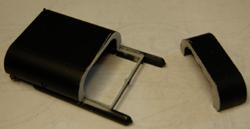
Building #2002 in the Quarter Pounder
paint scheme circa 2001
by Patrick Durand
The Atlas Model Railroad Co. Item #10 000 503 GP38-2 Alaska -Road #2002 in the Trainman line is a very credible model of the prototype. With a street price in the $80.00 range this is an excellent value with a very smooth well weighted power train. Pop off the dynamic brake housing and you can add any DCC decoder with or without sound, equipped with an 8 pin plug. All the lights will keep working!
This is the first commercially available "Quarter Pounder" paint scheme. (Big Mac describes the MAC 70 paint job). #2002 is accurate including the handrail stanchions and the F and GP38-2 lettering on the front corners. (#2001 will require painting the stanchions blue). Railbox Yellow is a perfect match, and half and half B&O Royal Blue and CSX Blue will match the blue used by Atlas. They did an excellent job.
There are no grab irons included with the Trainman but all the grab iron locations are dimpled. Center these with a sharp needle and follow up with a #76 drill and install your own 17" drop grab irons. All the grabs should be painted yellow on 2002 except for the curved grab behind the last fan.
Most modelers will be satisfied at this point with a fair representation of #2002 as it appeared in the Livingstone Rebuild Center Yard in May 2000 (at upper left).
If you want a truly unique model some minor modifications and additions will really bring your #2002 to the next level. A parts list appears at the end of the description. The only adhesive I used on this project was 2000 tire glue, applied with the end of a needle or toothpick. Near the windows I use Micro Chrystal Clear.
Start by popping off the fuel tank and removing a scale 4 feet from the rear to match the photos. While at it remove the round fuel gauge at the middle of the tank. (2001 kept this on the right side.) Repaint with Engine Black and add the safety markers. ( I make these by printing alternating red stripes on printer labels and then cutting them in sections and apply per the photos. You can add a few coats of clear gloss to the surface of these to keep them in place.) Don't worry about the rectangular section of the frame that sticks out behind the tank. Just paint it flat black and it will disappear to all but the most critical rivet counter.
The model does not have the square air filter box and large door. Match the prototype photo by removing the Dynamic housing and the adding styrene blocks to the sloped corners. I made these with a scale 8X8" strip of styrene rough filed on a diagonal through the mid section. Then apply the rough blocks with ACC so they extend beyond the flat surfaces of the model part. Use a large flat file to cut these filler blocks down to match the flat surfaces leaving sharp square corners to match photos. The new door on the left side is cut from .010 styrene sheet. Repaint with the CSX and B&O Royal blue mix. While the cover is off drill out the exhaust stacks and paint them black inside.
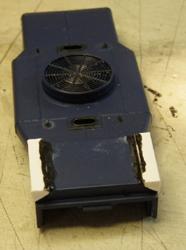 |
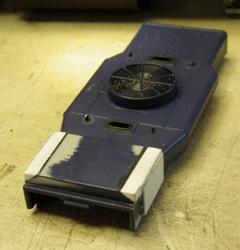 |
The horns are removed and replaced with Leslie 5 chime 3fw 2rw mounted just to the right of center line behind the cab. The Firecracker Antenna is mounted just left of center and 14 inches from the back of the cab roof. The Dual Pyle headlight is added at the centerline front edge of the cab where the old horns were.
Add the speed recorder on the right rear journal of the front truck. Drill out the end of the truck journal and cut it back about .030 to accept the body of the recorder and fix the recorder cable sweeping up to the side frame of the truck extending above the truck. I secure this with adhesive and paint the cable black. While working in this area add the step lights at the bottom edge of the frame just behind the jack stands. (These lights provide a point of reference for the crew by illuminating the roadbed below the cab window.)
MU stands with a single receptacle were added on each end platform just right of center. On the front platform Ditch Lights are mounted on elevated posts. On 2002 these are painted yellow while on 2001 they are painted blue. Install Kaydee whisker couplers. Coupler cut levers were made up from.010 wire and mounted with eye bolts. Install three MU cables on each side of the coupler on both ends.
On the right side of the body there is a sight gauge window in the 5th door from the rear. This should be drilled out, painted black and then glazed with Micro Crystal Clear. All the fans and vent openings can be enhanced with several careful washes of dilute Engine Black. Use your finger or dry paper towel to wipe the wash off the top of the fan housings to keep the blue detail in contrast with the recessed areas.
As a final touch, add the switcher mirror on the left side cab window. This allows the engineer to view signals passed by the conductor working on the ground on the left side of the locomotive. Drill #74 holes just above and below the center line of the window to accept a U shaped frame of wire. The mirrors are made by cutting a corner piece from packing plastic, reducing it to size and gluing the wire frame into the inside corner. Caution, using ACC adhesives here may discolor or fog the paint and windows. Use Micro Crystal Clear as adhesive. Painting the back side silver provides mirror surfaces. Insert the wire frame into the pilot holes and secure it with Micro Crystal Clear.
Materials List for ARR 2002 based on ATLAS Trainman locomotive.
Details Associates
Details West
Micro Scale Decals 87-527
Here are some views of #2002 running deadhead: .
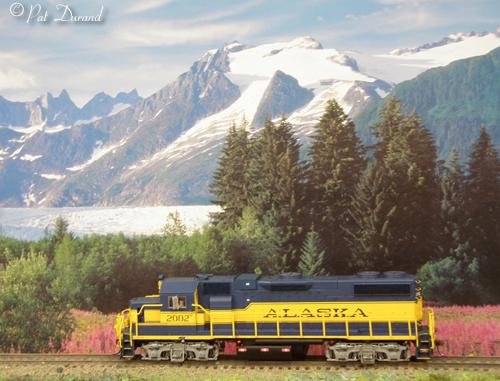
Past the Mendenhall Glacier on the Southeast rail extension
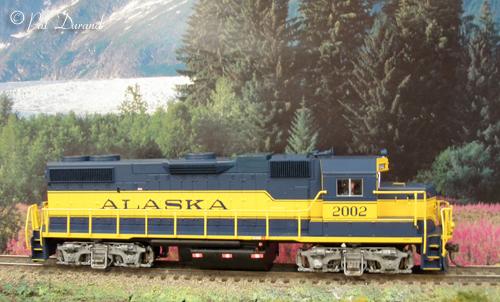
Going the other direction still light.
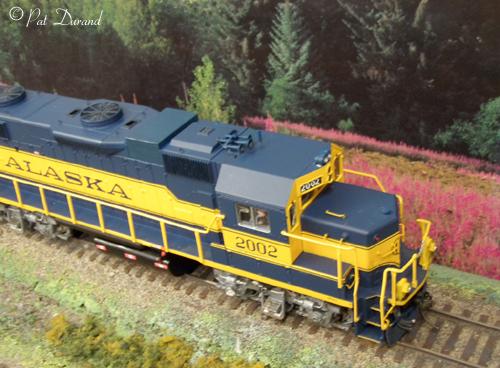
Caught up with her at the overpass to catch the roof details.
History of #2002
Alaska Railroad 2002 is a GP38-2 builders #786138-1 by EMD in December 1978. As #109 on the Butte Anaconda & Pacific she shared some unique features with a sister locomotive which later became ARR 2001. Both were owned by Rarus Ry before coming to the Alaska Railroad in April 1986.
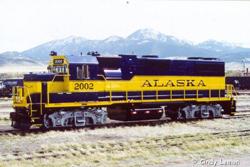
Number 2002 was sent to the Livingston Rebuild Center in Montana for an overhaul
in December 1999 and came back to Alaska in May 2000 in the new Baby Mac paint
known to most modelers as the "Quarter Pounders". Cindy Lemon provided
the builders photo below taken in the LRC yard.

John Combs photographed her after several years service and revealed the roof
details and weathering.

As of 2009 both 2002 and 2001 are in general service and are occasionally connected
with power car P-30 and used in short passenger consists.